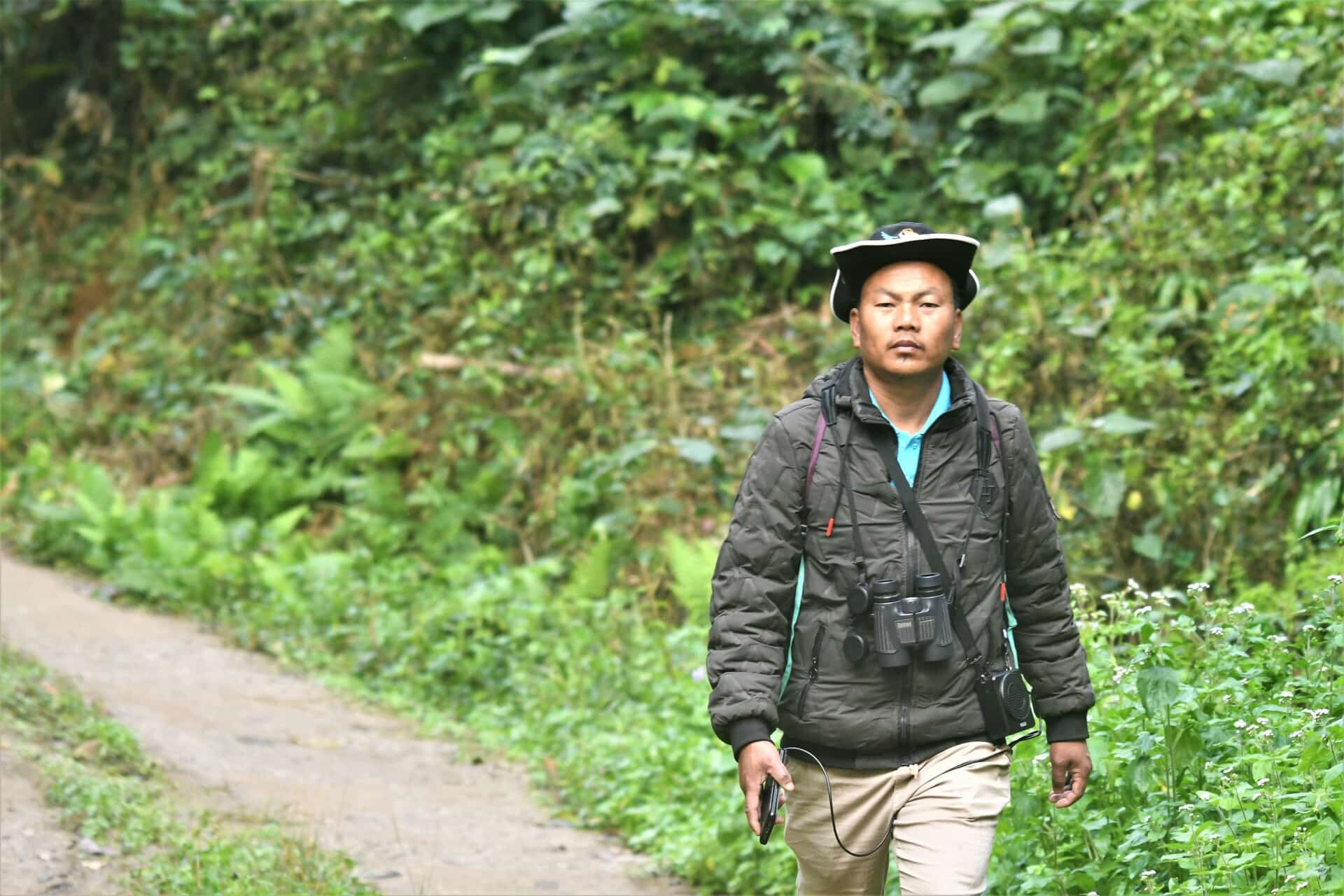In terms of responsible tourism, Northeast India is particularly exemplary. Few travelers know this, but it is one of the most important areas for biodiversity (Biodiversity Hotspot), where hundreds of tribal communities live in harmony with their environment.
It is understood that many people and communities are engaged in the conservation and preservation of species and their ecosystems and ancestral traditions which are deeply interlinked.
Here is a humble tribute to the anonymous heroes who fight every day to save their environment and by extension our planet. These people often take their entire lives to protect the environment.
Check them out here:
Assam
Jadav Payeng
Jadav “Molai” Payeng is an environmental activist from the Mishing tribe on Majuli Island. He is hailed as the forest man of India. Over the decades, he planted and maintained trees on the sandbanks of the Brahmaputra River, turning it into a forest reserve. The forest, called Molai Forest after him, covers an area of about 550 hectares. In 2015, he received the Padma Shri, the fourth highest civil prize in India.
The forest, which was known as the Molai Forest, is now home to Bengal tigers, Indian rhinos, and more than 100 deer and rabbits. It is also home to monkeys and several avian species. The forest has a rich biodiversity and several species of trees and plants that support its ecosystem.
Dr Purnima Devi and the Hargila Army
Dadara is a village located on the northern shores of the mighty Brahmaputra. The village is home to several large trees allowing the greater adjutant Stork to nest. In Assam, the scavenger is called ‘hargila’, which means ‘bone swallower’, which is why their protectors are called ‘Hargila Army’.
Dr. Purnima Devi Barman has dedicated her life to the preservation of the bird and has managed to enlist hundreds of villagers in her hargila army. The army focuses on protecting large trees because the big bird needs large trees to nest. As part of the conservation program, these women use their looms to represent endangered birds as a pattern on stoles and saris. They also protect nests by putting nets under trees to prevent young from falling and injuring themselves. The conservation project of the Greater Adjutant Stork has been extended in 2019 for two years, with a budget of about 75,000 euros.
Visiting Dadara is a great way to encourage the efforts of the villagers and to defend such acts of conservation.
Manoj Gogoi
Manoj was born in the Kaziranga region of Assam. He grew up in the heart of nature alongside rhinos, leopards, birds and reptiles. Growing up, he knew what he wanted to do and he was determined to move mountains for that. Although he left school early, Manoj trained at the Bombay Natural History Society in Mumbai in 2006.
With 11 like-minded people, Gogoi created his NGO — The Naturalists for snake and bird rehabilitation (NRSB) in 2007. Today, the organization has 100 volunteers. The career and remarkable experiences of this self-proclaimed naturalist have earned him many well-deserved distinctions. In 2014, the Corbett Foundation awarded him the “Wildlife Warrior” award and last year he became the subject of a documentary entitled “The Man Who Speaks the Language of Nature” directed by award-winning Assamese director Dhritiman Kakati.
Deborshee Gogoi

Deborshee Gogoi is an animal cartoonist from Tinsukia district, the eastern part of Assam. The district is well known for its rich biodiversity, ethnic diversity and natural resources. His penchant for wildlife began at an early age, when he was exploring the Bherjan forest by bicycle, just 2 km from his home.
He thinks that drawing is one of those creative mediums that can attract the public’s attention and make them smile while reflecting on the various environmental and social problems that he would otherwise have ignored.
Deborshee has created drawings and illustrations for organizations such as Bombay Natural History Society, Oil India Limited, Aaranyak, State Bank of India, OneforBlue, Zigzag India Tours and HEAL to name a few. His cartoons appear regularly in “Horizon” of the Assam Tribune.
Currently, he is an assistant professor in the Department of Commerce at Digboi College.
Rupjyoti Saikia
In the kingdom of the one-horned rhino, lives Rupjyoti Saikia Gogoi, an ambitious woman who has not confined the idea of “reducing, reusing and recycling” to promising slogans.
Rupjyoti, took matters into his own hands by empowering women in her community by providing them with a refuge to literally weave their lives – by founding the organization ”The Village Weaves”, which offers textiles through their NEDFi-supported outlet called ‘Kaziranga Haat’.
From cotton weaving to polyethylene bags, their initiative not only serves the cause of financial independence of local women in the region, but also the conservation of the natural fauna of Kaziranga National Park, because plastics do not choose to harm only humans, but all!
Tenzing Bodosa
Tenzing Bodosa is the owner of the world’s first elephant-friendly tea plantations. In his tea plantation of Tenzing Bodosa, you will see hornbills, wild boars, deers and peacocks, but that’s not all. At these two farms in the Bodoland region, you will also meet more than 70 elephants that have earned the plantation the certificate as the world’s first elephant-friendly farm.
Manas Maozigendri Ecotourism Society (MMES)
This NGO promotes conservation and ecotourism in adjacent areas of Manas National Park through community participation. Its greatest success has been to transform former poachers and those involved in illegal logging into protectors of forests and wildlife.
ARUNACHAL PRADESH
Ohey Tayeng – Pakke Nest Protector
Ohey Tayeng has been a hornbill nest protector in the Pakke Tiger Reserve in Arunachal Pradesh since 2013. He also works as a naturalist guide, with a very good knowledge of plants and birds.
The Pakke Reserve in western Arunachal Pradesh is a refuge for four species of hornbills, in an area where hunting and deforestation pose a serious threat to these birds. This Tiger Reserve is well-protected thanks to the efforts of the Forestry Department, but hornbills face ongoing threats outside protected areas.
It was therefore important to involve the Nyishi community, who live off the reserve, in the conservation of the hornbill habitat.
Since 2012, the NCF (Nature Conservation Foundation), with the help of the Ghora-Aabhe Society (a local NGO formed by Nyishi village chiefs to promote conservation around Pakke) and the Arunachal Pradesh Forestry Department, have successfully managed the Hornbill Nest Adoption Program. The program allows those who wish to adopt a hornbill nest.
The local community contributes by researching, monitoring and protecting nests in the forests around their villages, while the urban community contributes by financially supporting the program and helping as volunteers and as visitors.
The Singchung Bugun Village Community Reserve
In the forests inhabited by the Bugun tribe of the western district of Kameng in Arunachal Pradesh, 10 boys from the village take turns each week to patrol a special area of 17 square kilometers. Formed by the Tamil Nadu Police Task Force, young people in the region are voluntarily participating in what is probably the first government-community collaboration in the forest conservation sector.
The reserve is right next to the Eaglesnest Wildlife Sanctuary, a biodiversity hotspot, which is also home to the Bugun Liocichla – a new species of bird that has not been reported anywhere else in the world. Identified as a new species in 2006, the bird was first spotted by Dr. Ramana Athreya, an amateur ornithologist and astronomer at the Indian Institute of Scientific Education and Research in Pune in 1996.
Jibi Pulu
In Roing, Jibi Pulu works with the Adi community where hunting has been the way of life for centuries, regularly educating and helping them to adopt conservation.
Growing up in the Mishmi Hills of the Dibang Valley in Eastern Arunachal, it was a strange turn that allowed him to begin on the road to saving the environment. In Erin Brockovich’s style, Jibi Pulu investigated documents on the proposed dams that contained a deeper truth that people did not understand but had agreed to sign.
He started a campaign to educate people about the harmful effects of dams on the Dibang River, but corruption and lack of awareness drowned out his efforts. This failure was a turning point in Pulu’s life, realizing that education and access to information were the only solutions.
He used tourism as a tool to do so and created the Mishmi Hill Camp, a place for birdwatchers and nature enthusiasts to come and discover the incredible biodiversity that the place has to offer. During this process, it has also generated jobs for villagers, who are beginning to understand the importance of preservation.
Ngunu Ziro
Ngunu Ziro is a community organization registered with the government of Arunachal Pradesh. The main thematic areas of his work at present are the empowerment of communities by building their capacity; environmental conservation by promoting healthy traditional practices and school-awareness activities; subsistence initiatives for villagers; and promoting responsible tourism by encouraging the participation of local people in tourism activities.
Tana Jorjo Tana
Jorjo Tana, a man who has worked tirelessly for four years to protect forests and against illegal logging in the state, said his life was in danger because the “wood mafia” threatened him with serious consequences if he did not stop raising his voice against illegal logging. Tana had previously filed a petition with the National Green Court (NGT) to stop large-scale illegal logging in the Papum Reserve Forest (PRF), Seijosa and the Dissing Paso Circle of the Khelong Forest Division, Arunachal Pradesh. He also filed a complaint against the Divisional Forest Officer (DFO), the Kelong Forestry Division and an FIR against the Forestry Department.
Meghalaya
Morningstar Khongthaw
Morningstar’s job is unique in the world, he is in charge of the maintenance and construction of the famous living root bridges. These are huge footbridges sometimes suspended tens of meters high whose lifespan would be between 500 and 600 years. Architectural masterpieces created from living tree roots simply moved to shape these bridges. These bridges are often poorly maintained because they are forgotten or degraded by ignorant tourists. He created Living Bridge Foundation (LBF), a foundation dedicated to the preservation of this unique cultural heritage.
Robert Basan
A former nuclear engineer, Robert Basan has transformed himself into a curator with a passion for river fish. Based in the village of Umpung in the South West Khasi Hills, on the border with Bangladesh, he educated villagers for more regulated fishing and wildlife protection.
HURO
HURO is a conservation program of the Western Gibbon Hoolock, the only species of ape found in India. This primate is classified by the International Union for conservation of nature (IUCN) as one of the 25 most endangered primates (source 2010). Indeed, the wild population has dropped dramatically from about 100,000 to 3,000 individuals, or nearly 97, in the last thirty years. This situation is mainly due to trafficking, including the trafficking of pets and traditional medicine, as well as the loss of their habitat which is becoming more and more dramatic.
By setting up the first center for orphaned Western Gibbons Hoolocks in the Indian state of Meghalaya, HURO gave the Indian authorities the opportunity to enforce the Indian Wildlife Act of 1972 and the Washington CITES Convention, seizing illegally held individuals as well as products derived from wildlife trafficking. By hosting 9 Western Gibbons Hoolocks to date, 8 of whom are in the rehabilitation phase, HURO is home to the largest captive group in the world and represents a real hope for the conservation of the taxon.
Thrang Timung
Weaving is rooted in the life and culture of Umden’s women. Eri silk is particularly fascinating because it is treated without killing the silkworm. Silk cocoons are usually boiled with the worm inside to maintain a continuous filament, resulting in a smooth and shiny fabric. Interestingly, the eri silkworm rotates short segments of a filament and creates an open cocoon at one end that allows the moth to come out. This is why it is called the “silk of peace”, making it a very popular fiber among Buddhists.
The humid climate of northeastern India is very favorable to Eri silk culture. Women in Umden traditionally process, spin and weave as part of their daily lives. They introduce with pleasure all the stages of the production chain, from the breeding of silkworms to the spinning and coiling of silk, to the production and dyeing of the threads and finally the weaving. They also organize weaving classes for those who want to try the loom.
Supported by local government and public funding institutions such as the Meghalaya Industrial Development Corporation (MIDC) mandated to make self-help groups (SHG) a success, like many others across the state, Thrang has also campaigned with his peers. Timung set up a Self Help Group through which she and her friends continued to practice cocoon culture and spinning.
Nagaland
Phejin Konyak
Phejin Konyak is the great-granddaughter of tattooed headhunter Ahon, who was one of the first performers in the 1923 “Diaries of Two Tours in the Naga Hills” written by JH Hutton, the first ethnographer to venture into the Naga Hills during the Raj era. Phejin lives in Shiyong village, Mon district, Nagaland, India.
In addition to managing the farm and receiving guests from her host family, she travels to remote corners of Mon District to document her tribe’s tattoo tradition. Together with photographer Peter Bos, they documented all the tattoo patterns used by the Konyaks.
As an insider, it is special and personal for her to write the story of her ancestors. This is the first time that such intensive research and documentation on the art of tattooing has been carried out.
Bano Haralu
In October 2012, a 47-year-old journalist turned environmentalist Bano Haralu led a small group of conservationists at Doyang Reservoir to check whether the rumor of a large-scale bird hunt was true.
What they saw on that October day shook them. Amur’s falcons had been slaughtered for meat and for sale in markets throughout the state. By the end of the day, the scale and cruelty of the massacre they witnessed had stunned them.
Following this, Bano and his team partnered with the Nagaland government and local communities to launch the “Friends of the Amur Falcon” campaign to make falcons a source of pride for the community. Experts were invited to work with local governments and local communities to find solutions to the conservation crisis. Regular ground patrols have been set up at the roosting sites in forests, as well as frequent checks on local markets.
Manipur
Moirangthem Loiya Ngamba
In 2003, Moirangthem Loiya Ngamba was looking for land to create a green space for local communities. Passionate about nature, he recently founded his NGO, the Wildlife and Habitat Protection Society (WAHPS), to conserve the region’s natural wealth.
It was at this time that a farmer in the foothills of the Langol Range suggested visiting a nearby hill, Punshilok. With a name that literally means “Spring of Life,” this hill was once an important forest during the reign of King Luwang Ningthou Punshiba, a ruler whose descent many Manipuris trace. However, years of deforestation, forest fires and indiscriminate use of forest resources by villagers have rendered it sterile.
With the help of a few friends, Moirangthem began by cleaning the area. Then they cleaned and desanded the creek, making it a good source of drinking water for the people of the valley. This was followed by a major woodworking campaign, with young boys and girls working tirelessly to make Punshilok green again.
To ensure that the young trees were carefully fed and protected, Moirangthem decided to make Punshilok his home. He built a small hut and lived on the hill alone for the next six years. Under his careful action, lush green vegetation spread over the earth, giving it life.
A big thank you
A big thank you to them for fighting every day to preserve northern India is what we cherish so much. Their work to protect the environment, biodiversity and cultural diversity actually serves the planet and humanity as a whole!



